|
I am in the habit of dragging jpegs from my daily Internet wanderings onto my desktop into increasingly chaotic classification systems:
Friends in drag, Parties/Performative Resistance?, Police Brutality, Gay Police,Dykes Protesting Interconnected Forms of Oppression, Ernest Flower Power, Psychedelic/Political Buses, Facebook I, Facebook II, Etc. etc. etc.
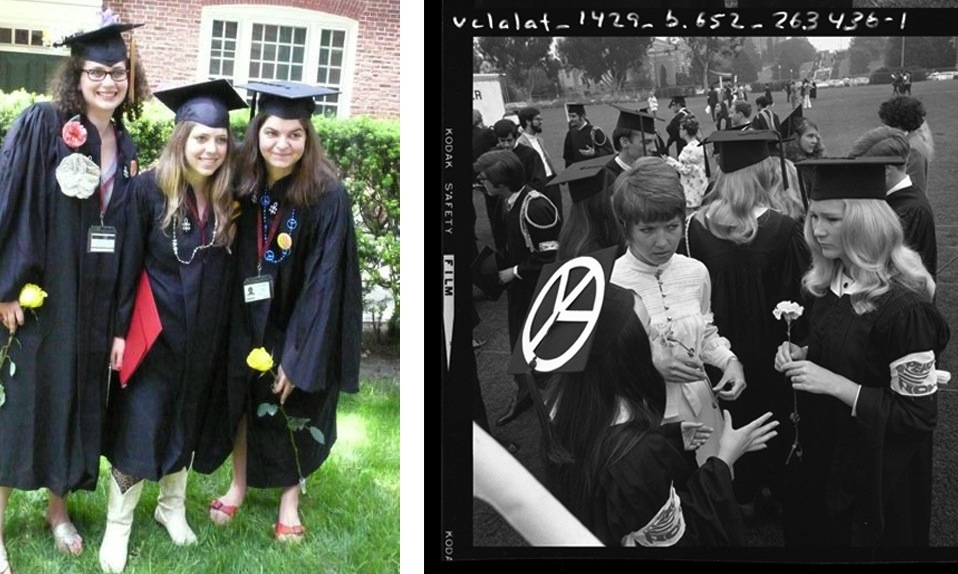
This archive began about a year and a half ago when I uprooted myself from the northeast to manifest some vision of my destiny in southern California. Homesick and longing for radical community, I began collecting images of my friends from Facebook. I found myself drawn to the ways in which we were performing our politics in personal space, from singing union songs after dinner to DIY drag nights in communally lived-in spaces. These intimate moments seemed loaded with political potential.
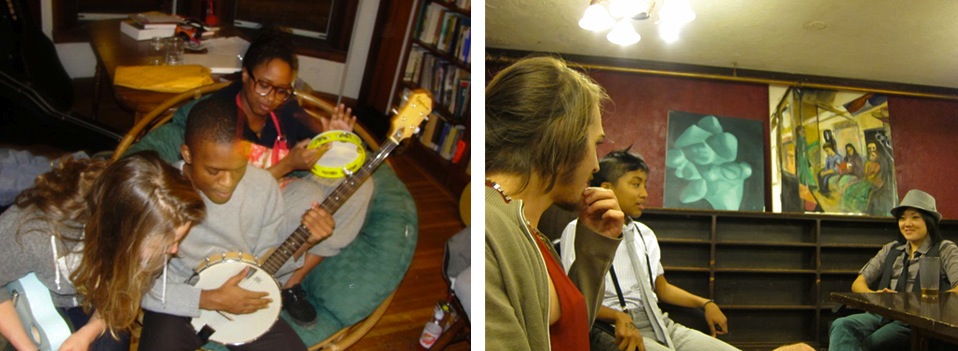
The images I was finding of my friends at demonstrations or participating in direct action seemed almost interchangeable with ones from parties or low-key gatherings. For example, to draw attention to Harvard’s labor practices, students staged a party to celebrate workers. Iman (author of a Case for Shit in Rethink) carried balloons and sported a metallic blue party hat and Remeike rocked a pink gorilla while strumming his banjo at a related event. Despite a bleak political landscape, I was accumulating evidence of joyful resistance happening in unexpected places.

I began thinking about how to activate the potential of these images off of Facebook; where they are subject to censorship and surveillance, political bite is muted by virtual clutter and evidence of LBGT activism instantly translates to an add for gay wedding planners or cruise lines on your welcome page. I wanted to piece together representations of disparate individuals into community. Simultaneous to this, I was looking for community my new city. At first eagerly anticipating chance-encounters with like-minded people in coffee shops and parks, I quickly remembered people float around on their phone or computer in the same individualized bubbles as they do in virtual space.
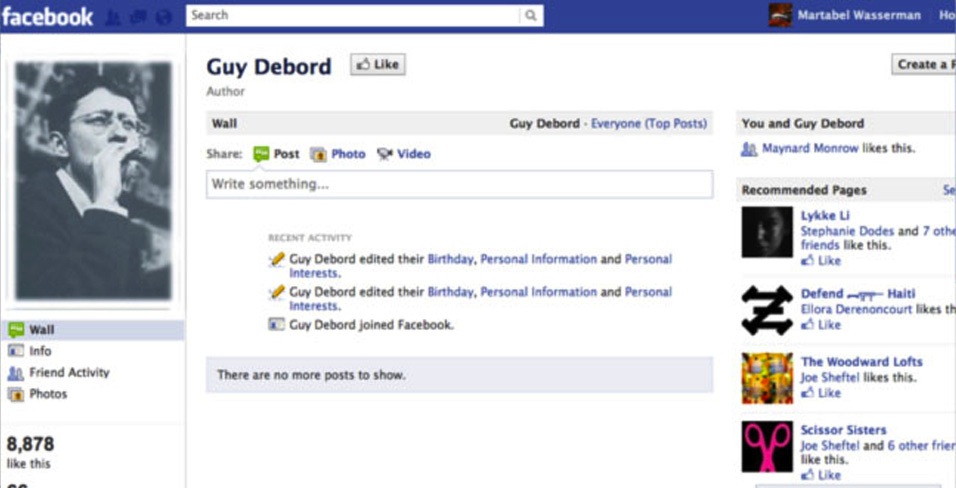
I began printing images from my pixelated archive and photographing them in my physical environments; creating imagined utopias of my friends throwing dance parties in front of the industrialized coastline of Long Beach or staging protests in the middle of the designed-to-be-riot-proof UC Irvine campus and my graduate student studio. I was trying so hard to imagine into being a fluid connection between virtual and embodied activism, local and decentralized community. I was literally trying to cut and paste two disconnected spheres together and failing each time.
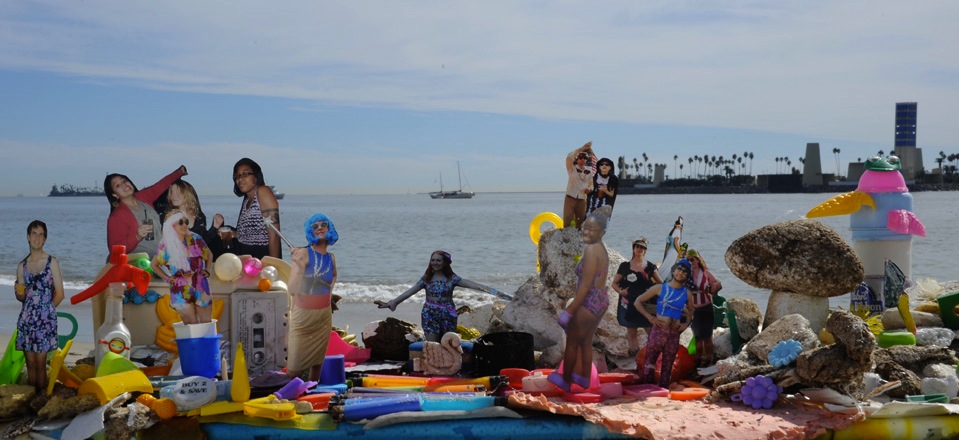
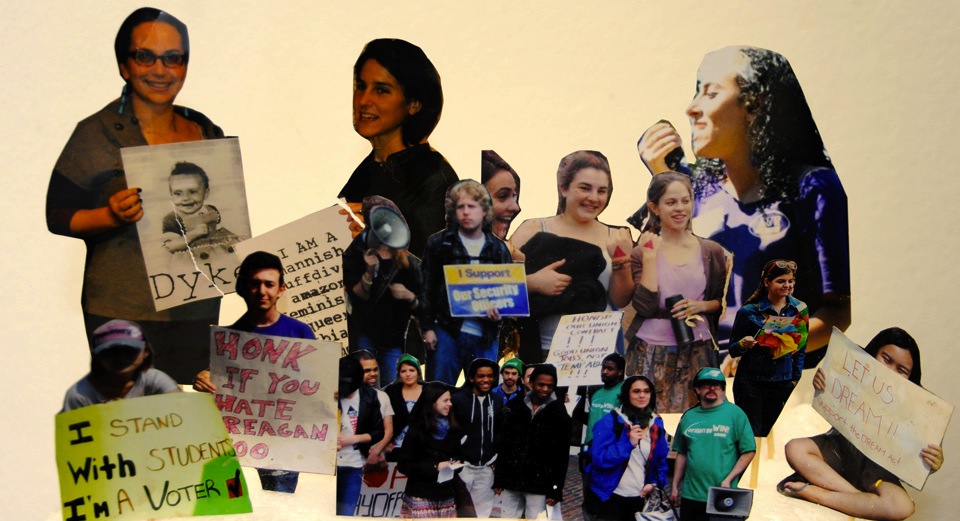
As I was thinking about how to mobilize political community, I began with the most literal example: the political bus. I became fascinated with buses as a way to stage interventions in the landscape, to create tumbleweed communities that forge both embodied bonds and psychic ones facilitated through media representation.
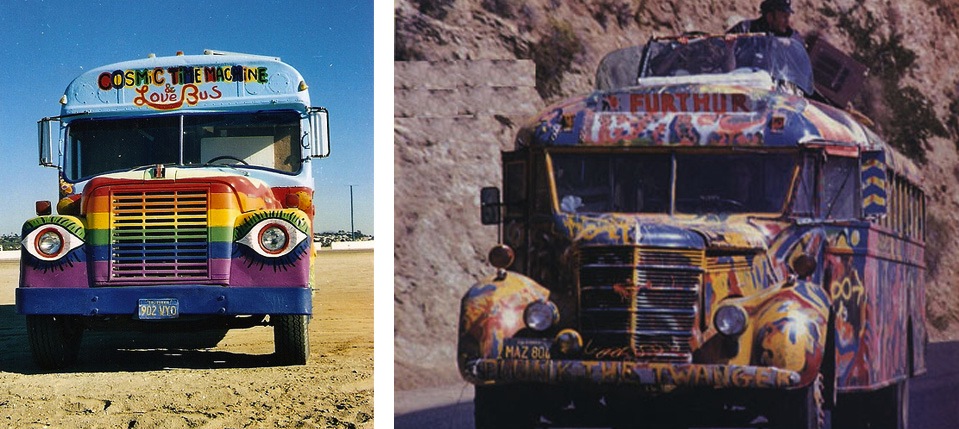
Once again, I found myself sifting through the history and mythology of the 60s for strategies to salvage. Once again, I was creating a false dichotomy between the counter-culture and the New Left. I wanted to move past the stale debates about the pros and con’s of each approach and began looking for examples of how a politics of pleasure and personal liberation can be used to critique structural inequality. I was not going find this in the contemporary LBGT movement, where pride parades are strings of corporate sponsorships doused in rainbow. This archival impulse led to my collection of images of queers protesting forms of oppression not explicitly connected to sexuality in the public imagination. This process of association is how my desktop got more and more cluttered and my political frustration more and more amplified. I was looking for ways to make meaningful contributions in the virtual and local spheres I occupied, dragging the past through the present, isolated moments into collaged collective fantasy, my internal landscape through a socio-political one.

Then something really amazing happened.
A protest in the United States actually captured the nation’s attention. Almost overnight I went from having no local political community to a new group of friends and comrades working together to take over public space where we could plot direct action, educate each other and share moments of radical intimacy. Consciousness-raising happened on a global scale and people saw their individual frustration is in fact collectively felt.
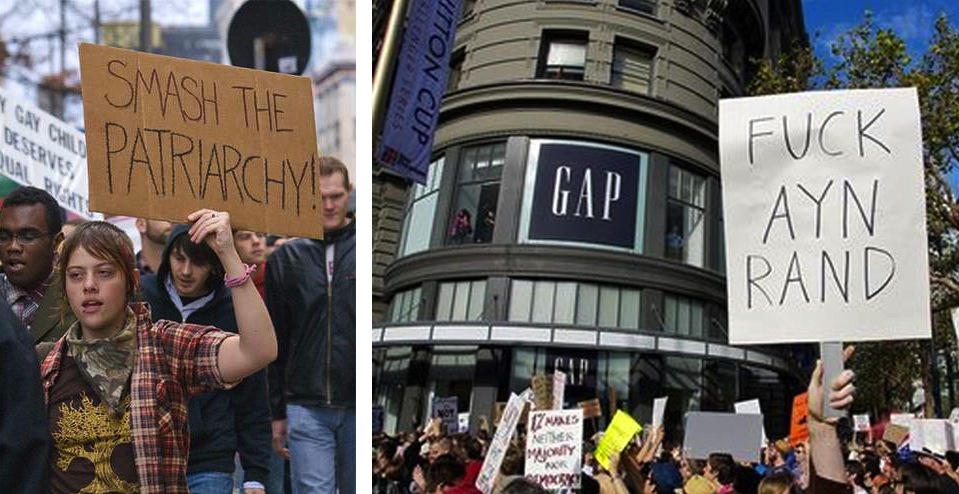
Thinking about what the Occupy Wall Street movement can accomplish is quite the mind fuck. How do you make revolutionary change in a country so geographically expansive, with so many disparate centers of power and pods of resistance from sea to shining sea? The imperialist legacy maintains its tight grip upon imagining new possibilities. However we all ready see the movement’s impact in many ways, a few of which include:
-The frequency with which income inequality is discussed in the mainstream media
-An estimated 70,000 people switching from big banks to local credit unions on Move Your Money Day
-Nixing of the Keystone XL pipeline
-Mobilized masses around the unjust criminal persecution faced by Bradley Manning
-Its appearance in popular culture from Miley Cyrus’s dedication of a music video to the movement and Kayne West’s quick commodification of dissent aesthetic.
I think of the movement as the key to unlocking spaces for cultural production that were foreclosed upon in the decade following 9/11. We had almost resigned ourselves to accepting that corporate interests have complete control of the public sphere, we almost believed protest was just a nostalgic pastime. Now that those fallacies have been debunked, it suddenly feels like the sky is the limit.
The editors of RECAPS have been kicking around the idea of a publication for a while, but I don’t believe it is coincidental that it has only now gotten off the ground.
We have witnessed the power of alternative media first hand this past year: people around the world used mobile phones and social networking to fight tyranny, Adbuster’s made a now infamous call to action that launched a social movement, Democracy Now! was cited as a catalyst for civil engagement in Time magazine’s feature on the protestor as the person of the year. While our project is more closely related to a history of feminist, queer, and DIY art and culture magazines than that of leftist news media, as we move forward into arguably the most inclusive social movement in this country to date I find it important to recognize that the distance between these two types of projects is getting smaller as their relationship is reframed from antagonistic to mutually beneficial. Pieces like Karen Narefsky’s Notes from the Underground serve as an example of how we are trying to bridge these discourses.
The prefix re gets to the heart of our project: to look backwards in order to move forward. We are refreshing tactics, repeating and reworking ideas, redoing the artist’s magazine format as our alternative space. Produced by working groups around Boston, NYC and LA, this issue marks the beginning of our experiment in local and virtual community building. Instead of a singular editorial statement we have four. This is our Reclaim portion of the site. We ask you as readers to help us rethink and revaluate these ideas each issue. RECAPS is a site for us to see what emerges when we bring our individual and collective fantasies about reclaiming culture, art, politics and sexuality together.
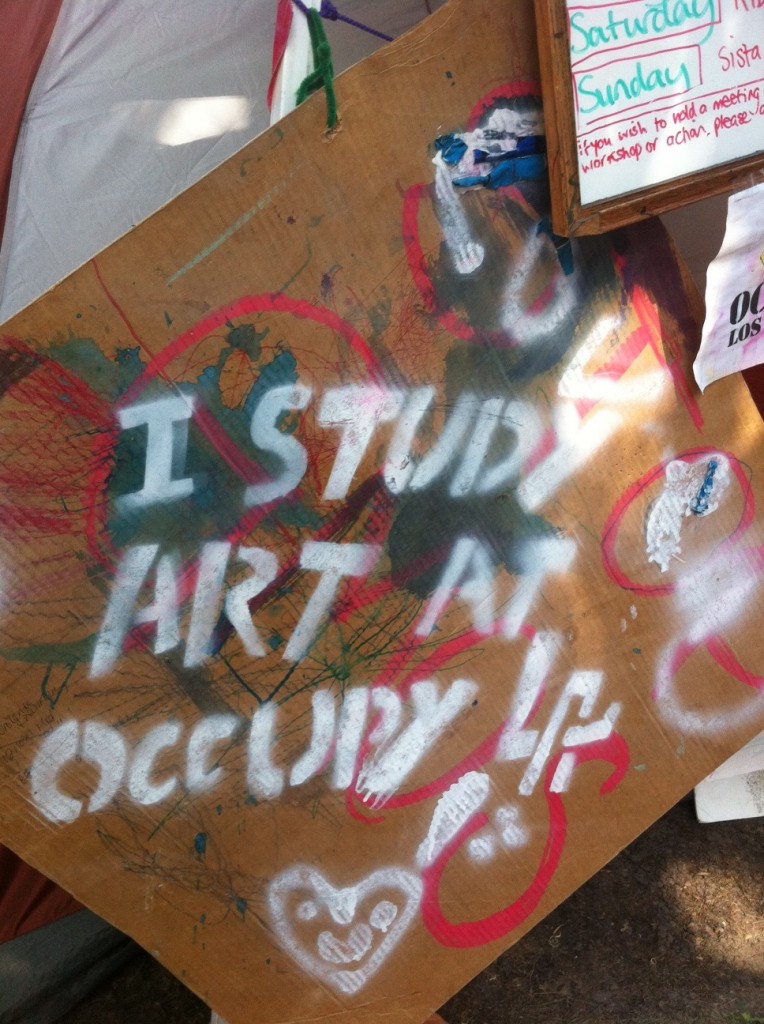
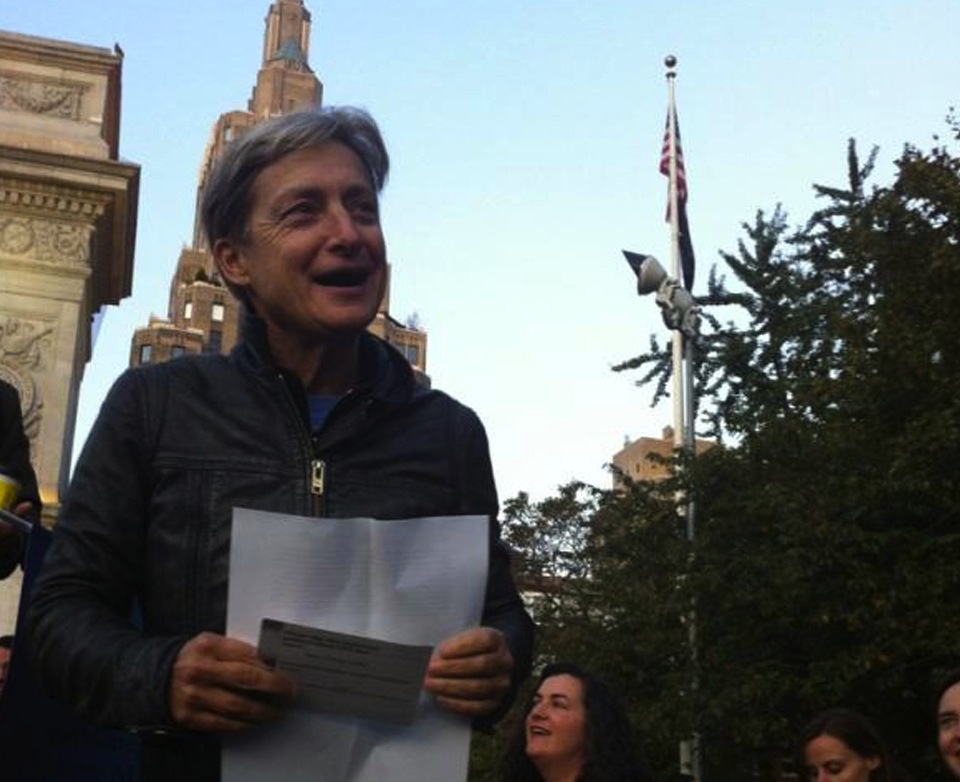
The issue started with the idea of a collection of download-able posters, available in our Reprint section. We want to explore the relationship between virtual and material tools for protest by starting an archive of high-res images. I am pleased to share the new work generated for this project by Andy Brown, Christopher J. Lee, Rebecca Lieberman, Catherine Lord, Robert Ochshorn, Manjulika O’Rourke, Sister Comrade, Yvonne Rainer, and myself. In addition, we collected historical work that felt timely to us. This archival work includes images by Andrea Bowers, Dyke Action Machine, fierce pussy, John Lennon and Yoko Ono, Ulysses Jenkins, Girls in the Nose and Meat Joy.
While you are printing out posters and mixing your wheat paste, enjoy the two annotated playlists in our Remix section. Female Noize takes on a tour of queer feminist punk while Gustavo Turner’s Blue Seduction is a luscious trip in an entirely different key.
The potential in reactivating and reproducing historical materials repeats throughout this issue. Cruising the Archive with Ann Cvetkovich, an impromptu salon with Kathryn Garcia, Catherine Lord and Martabel Wasserman, uses the ONE Archive as staging ground to talk about the relationship between the archive and activism in our current political moment. The one and only Ms. Vaginal Davis was also found digging through LA’s queer archives in her take on the Women’s Building My Pussy Still Lives in Los Angeles (I only live in Berlin). Writing Reclaim Theory from London, Martin Eiermann suggests that we dust some cobwebs off the Left’s canon in order to effectively employ historical ideas in contemporary politics. Boston-based artist Alex Moore-Niemi explores the history of LBGT representation and the external gaze produced in traditional film processing in The Queer Polaroid Project. In his first installment of what will be an on-going feature in the magazine, Alex shares his strikingly honest and beautiful self-portraits alongside found photographs.
We are fortunate to have some truly fresh and radical takes on the central role policing of sexuality plays in constructing systems of marginalization, exploitation and oppression. The Boston-based group Black and Pink interrogates the relationship between the prison industrial complex and queer liberation. Each month they receive hundreds of drawings and letters from behind bars, a few of which they generously shared with us for this issue. Raúl Alcaraz’s Indocumentaliso Manifesto offers a critique of the current state of colonialism as he positions himself alongside and in opposition to current immigrant youth organizing, most obviously mobilized around the Dream Act. Also looking at the relationship between sexuality, citizenship and borders, we are pleased to be reprinting Sarah Schulman’s Pink Washing: A Documentary Guide. Boris Torres’s paintings of group sex in BT Art and Porn explore community formation, nationality, sports and the relationship between public and private space.
A reoccurring trope in this issue is the relationship between religion and sexuality. Christopher J. Lee’s Unlimited Intimacies: Promiscuous Reflections on Barebacking and Catholic Dogma interrogates the academic disciplines of queer theory and religious studies with his fascinating take on the relationship between the two. Iman James’s A Case for Shit is a fabulous introduction to abject aesthetics. Christopher Johnson-Roberson shares with us his tender and biting poem St. Valentine.
Constructing childhood and adolescent sexuality is another theme taken up by artists in this issue. At the height of Lady Gaga and It Gets Better, RL Goldberg offers us an intimate take on adolescent gay sexuality in How An Oyster Makes His Shell. Stephanie Dode’s video No Telos No Beauty seeks to mime pop culture in order to subvert it. The videos of A. Murphy , In Search of Lost Know-How offer both practical tips and insightful commentary on constructing queer identity. Vadis Turner’s Ribbon Paintings are opulent aesthetic experiments that contribute to an on-going dialog about the role of craft in feminist art and politics.
In honor of the late Mike Kelley, Caren Splinter shares with us pictures from a DIY memorial to the artist in Echo Park, as well as some memories in Mor Lovehours.
I want to leave you with a portrait I did of the editors. As I sit writing this from the desk where I took this picture in my studio at UCI, I am able to reclaim a space where not too long ago I felt I had to single-handedly resolve my confusion, perform some predetermined version of artist, and hold onto institutional privilege with all my might or else be destined to have no legitimate creative voice. Once again, these ideas of artistic and intellectual production are being dislodged. Histories of alternative methods are rediscovered. The real stakes become clearer. We need to cultivate every possible crevice for collective thinking that we can.
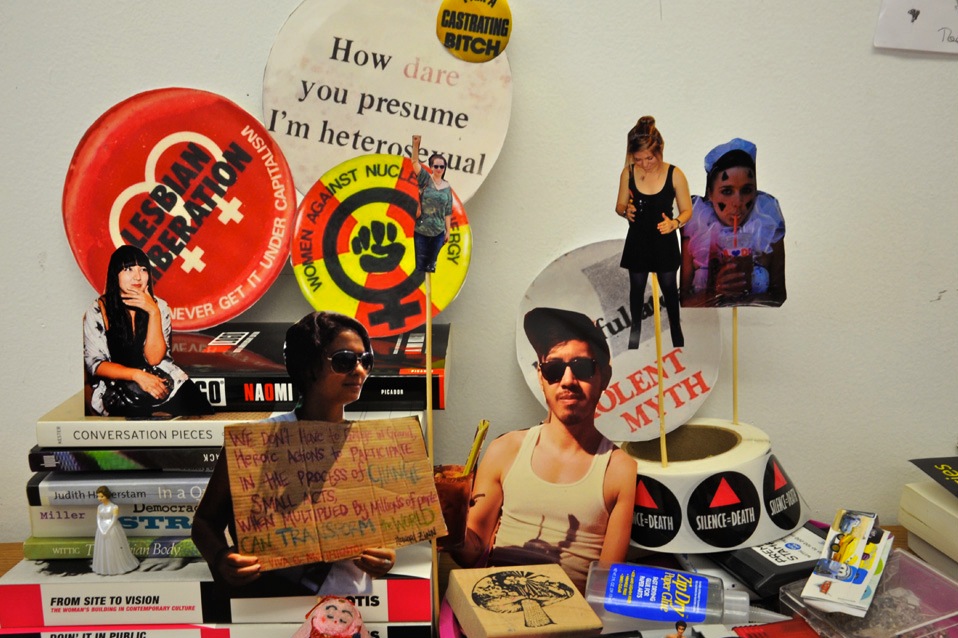
|